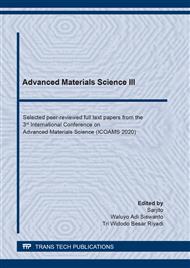[1]
N. S. Stolo, C. T. Liu, and S. C. Deevi, Emerging applications of intermetallics,, Intermetallics, vol. 8, p.1313–1320, (2000).
DOI: 10.1016/s0966-9795(00)00077-7
Google Scholar
[2]
R. M. & P. J. D. C. M. Ward-Close, Intermetallic-matrix composites-a review,, Intermetallics, vol. 9795, no. 95, p.217–229, (1996).
DOI: 10.1016/0966-9795(95)00037-2
Google Scholar
[3]
F. Yang and D. Zhao, Effect of alloying elements on the electronic structure of NiAl,, Mater. Sci. Forum, vol. 475–479, p.3107, (2005).
DOI: 10.4028/www.scientific.net/msf.475-479.3107
Google Scholar
[4]
X. Zhu, T. Zhang, D. Marchant, and V. Morris, Combustion synthesis of TiC–NiAl composite by induction heating,, J. Eur. Ceram. Soc., vol. 30, no. 13, p.2781–2790, Oct. (2010).
DOI: 10.1016/j.jeurceramsoc.2010.06.002
Google Scholar
[5]
G. Gottstein, K. Reichert, K. Wen, R. Cremer, W. Hu, and D. Neuschu, Influence of BN fiber coatings on the interfacial structure of sapphire fiber reinforced NiAl composites,, Appl. Surf. Sci., vol. 179, p.150–155, (2001).
DOI: 10.1016/s0169-4332(01)00255-0
Google Scholar
[6]
S. Hou, Z. Liu, and D. Liu, The study of NiAl–TiB2 coatings prepared by electro-thermal explosion ultrahigh speed spraying technology,, Surf. Coat. Technol., vol. 205, no. 19, p.4562–4568, (2011).
DOI: 10.1016/j.surfcoat.2011.03.122
Google Scholar
[7]
X. Zhu, T. Zhang, V. Morris, and D. Marchant, Combustion synthesis of NiAl/Al2O3 composites by induction heating,, Intermetallics, vol. 18, no. 6, p.1197–1204, Jun. (2010).
DOI: 10.1016/j.intermet.2010.03.009
Google Scholar
[8]
X. Wang, X. Feng, C. Lu, G. Yi, J. Jia, and H. Li, Mechanical and tribological properties of plasma sprayed NiAl composite coatings with addition of nanostructured TiO2/Bi2O3,, Surf. Coatings Technol., vol. 349, no. May, p.157–165, (2018).
DOI: 10.1016/j.surfcoat.2018.05.055
Google Scholar
[9]
X. jie Song, H. zhi Cui, L. li Cao, and P. Y. Gulyaev, Microstructure and evolution of (TiB2+Al2O3)/NiAl composites prepared by self-propagation high-temperature synthesis,, Trans. Nonferrous Met. Soc. China (English Ed., vol. 26, no. 7, p.1878–1884, (2016).
DOI: 10.1016/s1003-6326(16)64265-6
Google Scholar
[10]
P. Lazar and R. Podloucky, Ductility and magnetism: An ab-initio study of NiAl–Fe and NiAl–Mn alloys,, Intermetallics, vol. 17, no. 9, p.675–679, Sep. (2009).
DOI: 10.1016/j.intermet.2009.01.012
Google Scholar
[11]
A. G. Merzhanov, Combustion Processes That Synthesize Materials,, J. Mater. Process. Technol., vol. 56, no. Elsevier, p.222–243, (1996).
Google Scholar
[12]
P. Mossino, Some aspects in self-propagating high-temperature synthesis,, Ceram. Int., vol. 30, no. 3, p.311–332, Jan. (2004).
DOI: 10.1016/s0272-8842(03)00119-6
Google Scholar
[13]
J. J. Moore and H. J. Feng, Combustion synthesis of advanced materials: Part I. Reaction parameters,, Prog. Mater. Sci., vol. 39, no. 4–5, p.243–273, Jan. (1995).
DOI: 10.1016/0079-6425(94)00011-5
Google Scholar
[14]
K. Morsi, Review: reaction synthesis processing of Ni–Al intermetallic materials,, Mater. Sci. Eng. A, vol. 299, no. 1–2, p.1–15, Feb. (2001).
DOI: 10.1016/s0921-5093(00)01407-6
Google Scholar
[15]
J. J. Moore and H. J. Feng, Combustion Synthesis of Advanced Materials: Part II. Classification, Applications and Modelling,, Prog. Mater. Sci., vol. 39, p.275–316, (1995).
DOI: 10.1016/0079-6425(94)00012-3
Google Scholar
[16]
T. W. B. Riyadi, T. Zhang, and Sarjito, Microstructure and Adhesion of NiAl/Al and NiAl/Ni Coatings Formed by SHS Process,, Appl. Mech. Mater., vol. 660, p.185–189, (2014).
DOI: 10.4028/www.scientific.net/amm.660.185
Google Scholar
[17]
L. Y. Sheng, F. Yang, J. T. Guo, T. F. Xi, and H. Q. Ye, Investigation on NiAl–TiC–Al2O3 composite prepared by self-propagation high temperature synthesis with hot extrusion,, Compos. Part B Eng., vol. 45, no. 1, p.785–791, Feb. (2013).
DOI: 10.1016/j.compositesb.2012.05.038
Google Scholar
[18]
T. W. B. Riyadi, T. Zhang, D. Marchant, and X. Zhu, NiAl–TiC–Al2O3 composite formed by self-propagation high-temperature synthesis process: Combustion behaviour, microstructure, and properties,, J. Alloys Compd., vol. 805, p.104–112, (2019).
DOI: 10.1016/j.jallcom.2019.04.349
Google Scholar
[19]
T. W. B. Riyadi, Structure and properties of ni˗al˗ti systems formed by combustion synthesis,, Mater. Sci. Forum, vol. 991 MSF, p.44–50, (2020).
DOI: 10.4028/www.scientific.net/msf.991.44
Google Scholar
[20]
N. Bertolino, M. Monagheddu, A. Tacca, P. Giuliani, C. Zanotti, and U. Anselmi Tamburini, Ignition mechanism in combustion synthesis of Ti–Al and Ti–Ni systems,, Intermetallics, vol. 11, no. 1, p.41–49, Jan. (2003).
DOI: 10.1016/s0966-9795(02)00128-0
Google Scholar
[21]
T. W. B. Riyadi, T. Zhang, D. Marchant, and X. Zhu, Synthesis and fabrication of NiAl coatings with Ti underlayer using induction heating,, Surf. Coatings Technol., vol. 258, p.154–159, (2014).
DOI: 10.1016/j.surfcoat.2014.09.037
Google Scholar


